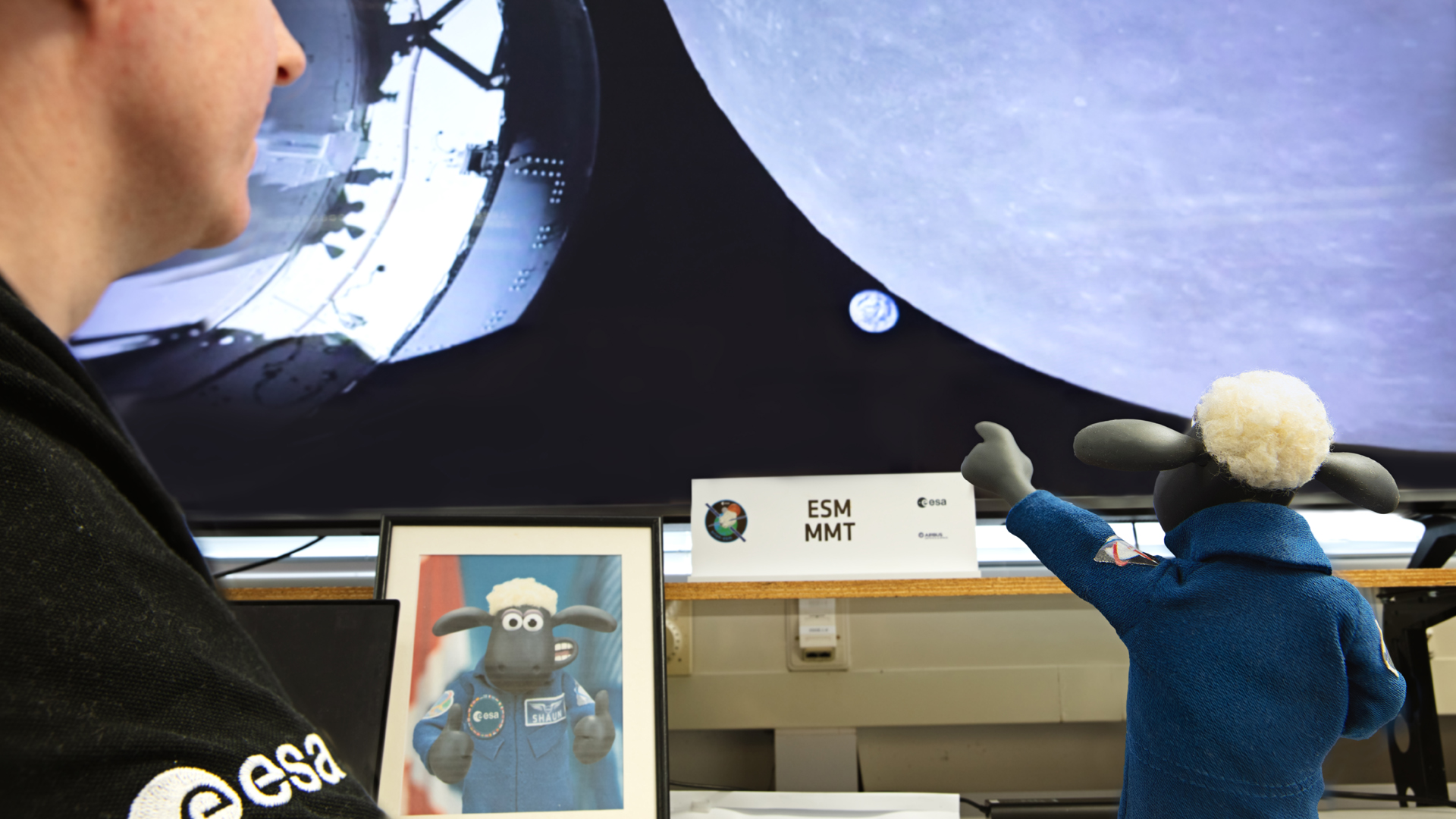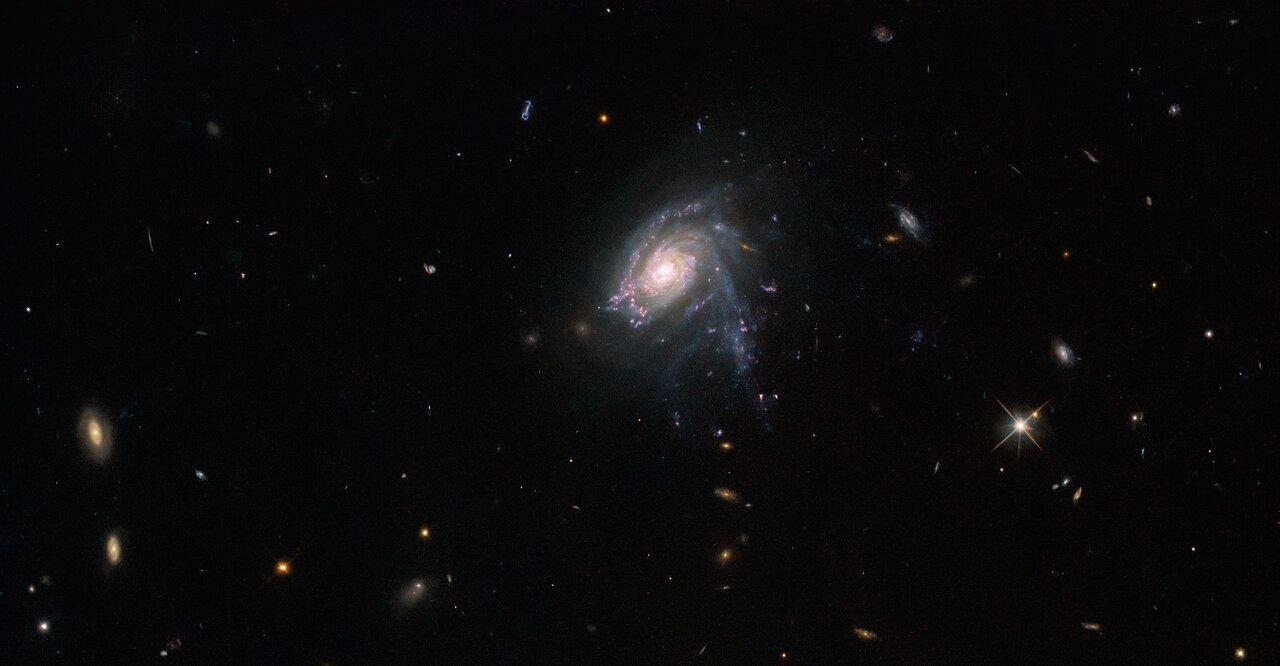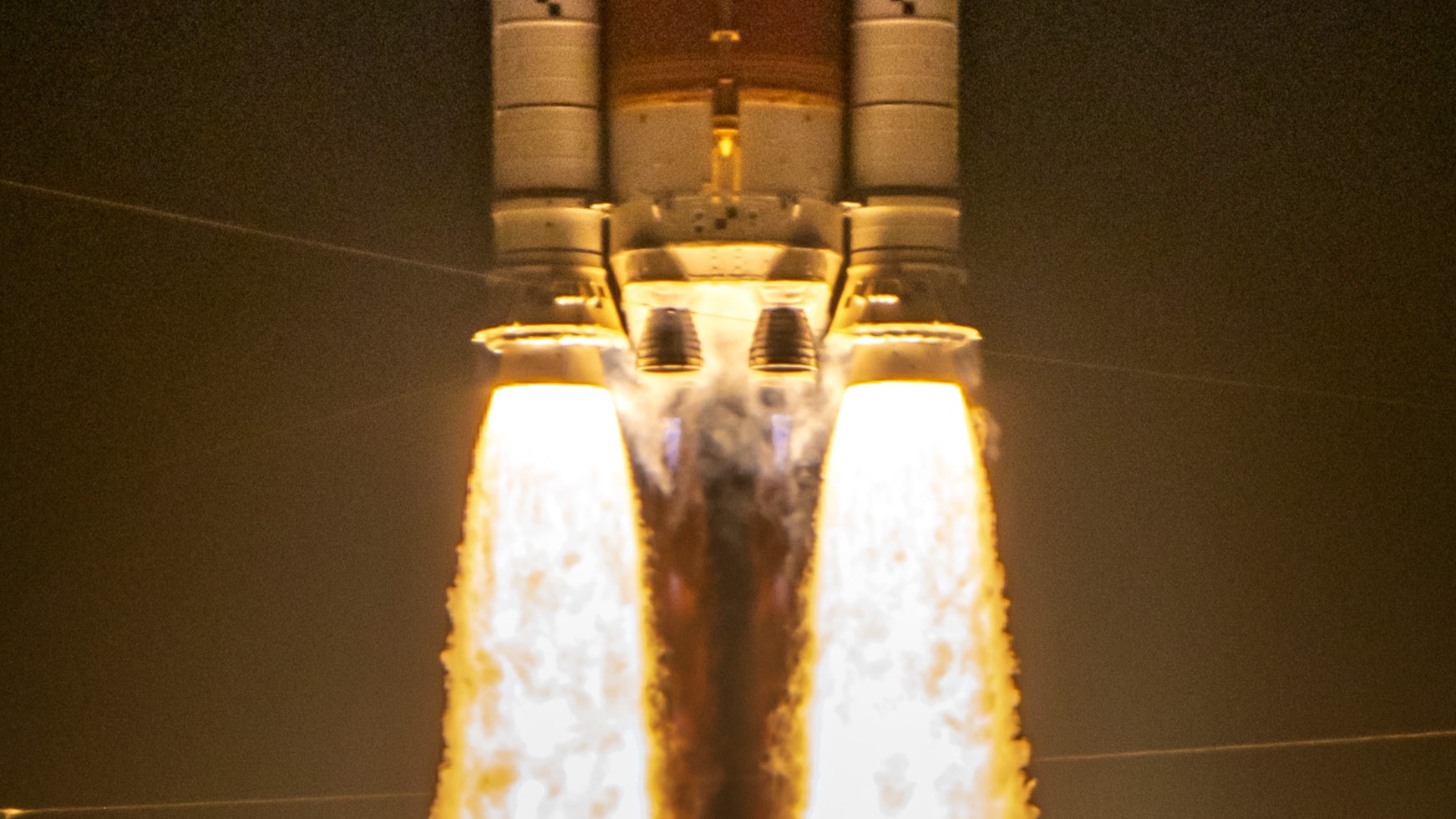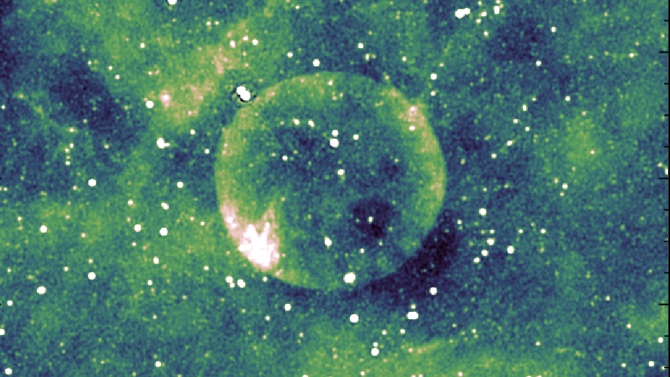May 2023
Ax-2 mission splashes down in the Gulf of Mexico

Wednesday, May 31, 2023: The SpaceX Dragon crew capsule Freedom splashed down safely in the Gulf of Mexico with four crew members of the Ax-2 mission on board, ending Axiom Space's second privately funded visit to the International Space Station.
The mission, commanded by former NASA astronaut Peggy Whitson, lasted ten days and brought to the orbital outpost the first two Saudi nationals, astronauts Ali AlQarni and Rayyanah Barnawi. American businessman John Shoffner also took part in the flight. – Tereza Pultarova
Ax2 astronauts working on space station prior to Earth return

Tuesday, May 30, 2023: Ax-2 astronauts Rayyanah Barnawi and her colleague Ali Alqarni work on life science experiments at the International Space Station.
The two astronauts, both Saudi nationals, arrived at the space station on Monday, May 22, as part of the second private mission to the orbital outpost operated by the U.S.-based company Axiom Space.
Barnawi and Alquarni are the first Saudis ever to visit the orbital outpost. Barnawi is also the nation's first woman in space. The two arrived at the space station together with former NASA astronaut, now an Axiom employee Peggy Whitson, and businessman John Shoffner. The crew is set to return to Earth aboard SpaceX's Freedom crew capsule later today.
Axiom conducted its first mission in April last year. – Tereza Pultarova
Zero-g fun

Monday, May 29, 2023: . Flying in space can be serious work, but that doesn't mean there isn't time to have some fun. Here, Saudi Space Commission astronaut Rayyanah Barnawi takes a break from science experiments on the International Space Station to pose for a fun snapshot during her Ax-2 mission last week. Barnawi is the first female astronaut from Saudi Arabia to fly in space as one of two Saudi mission specialists on the Ax-2 mission by Axiom Space. – Tariq Malik
Get the Space.com Newsletter
Breaking space news, the latest updates on rocket launches, skywatching events and more!
Europe's Jupiter moon explorer JUICE completes instrument deployment

Friday, May 26, 2023: The European Space Agency's (ESA) Jupiter mission JUICE has completed the deployment of its instruments six weeks after its launch.
The spacecraft, officially called the Jupiter Icy Moons Explorer, unfolded the antennas of its Radio & Plasma Wave Investigation (RPWI) instrument on Friday, May 26, completing a challenging early phase of its mission. Previously, the spacecraft's operators struggled to deploy the 52-foot-long (16 meters) antenna of the probe's ice-penetrating radar. The instrument was jammed for three weeks because of a stuck pin, and it took some ingenuity to release it.
With the deployments complete, JUICE will continue its eight-year voyage to the solar system's largest planet where it is scheduled to arrive in 2031. – Tereza Pultarova
Virgin Galactic aces test flight

Thursday, May 25, 2023: Virgin Galactic has successfully completed a test flight that will pave the way for the company to commence commercial space tourism operations.
The flight was the fifth suborbital sortie for Virgin Galactic's VSS Unity space plane and the first since July 11, 2021, when Virgin Group founder Richard Branson was one of the passengers. That flight, however, deviated from its approved path during its return to Earth, prompting an investigation by the Federal Aviation Administration due to concerns the mishap may have put other aircraft at risk.
The Thursday flight saw Virgin Galactic's twin-fuselage mothership Eve carry the VSS Unity spaceplane to an altitude of roughly 50,000 feet (15,000 meters). After its release from the mothership, the spaceplane continued to the edge of space, to the altitude of 50 miles (80 kilometers), treating its eight passengers to about three minutes of weightlessness. The plane successfully landed at Spaceport America in New Mexico about 1 hour and 15 minutes after take off. – Tereza Pultarova
LEGO sends 1,000 astronauts to space and lands them safely in a mini space-shuttle

Wednesday, May 24, 2023: One thousand LEGO astronauts traveled to the edge of space on a stratospheric balloon last weekend and returned safely to Earth on a specially designed landing platform.
The Legonauts took off from a small airport in Slovakia, seated on a 3D-printed space shuttle-like platform made of a sturdy but lightweight carbon composite material. The shuttle was designed by a team of space architects and engineers from Slovakia and the Czech Republic passionate about inspiring future generations to learn about space, according to the website Czech Crunch.
The balloon took the mini-spacefarers to the altitude of 21 miles (34 kilometers) where it burst. The landing platform then returned to Earth under a parachute. According to space architect Tomas Rousek, the team had to make sure that none of the astronauts fell off the roof-less shuttle during the early stages of the platform's descent. Two cameras filmed the experiment throughout the ride, one monitoring the crew compartment, the other, attached to a boom, filming a view of the entire platform.
The LEGO astronauts will now be put up as a prize in a draw in the Czech Republic and Slovakia for those who buys and register a new LEGO set. – Tereza Pultarova
Hubble may have found a rare medium-sized black hole

Tuesday, May 23, 2023: The Hubble Space Telescope may have found a rare medium-sized black hole. Although scientists are not sure yet.
The black hole may be lurking at the heart of a globular cluster in our Milky Way Galaxy some 6,000 light-years away from Earth.
Most known black holes are either quite small, the so-called stellar black holes, most of which are only a few times as massive as our sun, or extremely large. The latter category are the supermassive black holes at the center of most galaxies. These cosmic monsters have masses equivalent to millions or billions of solar masses.
A stellar black hole is born when a massive star collapses at the end of its life. By gradually devouring matter and by merging with other black holes, the black hole grows. At least in theory. The problem is that until now, scientists have not seen many medium-sized black holes, which should represent the natural step in the evolution of black holes from stellar to supermassive.
The new suspected black hole, which appears to reside in the globular cluster Messier 4, may have a mass of about 800 masses, according to the European Space Agency. Although the Hubble Space Telescope can't see the black hole directly, the motion of stars inside the cluster tells astronomers that some invisible heavy object must be present. – Tereza Pultarova
Shaun the Sheep to the moon and baa-ck on Baa-Temis I

Monday, May 22, 2023: An image taken at the Mission Evaluation Room of the European Space Agency (ESA) technical center ESTEC in Noordwijk, the Netherlands shows it receiving a very distinguished visitor, Shaun the Sheep.
The first lunar "lamb-bassador" of Europe, and probably of anywhere else, was at the ESA center on Thursday, May 19, to check up on the Orion spacecraft. The sheep and the spacecraft have a special bond, as it was Orion that carried Shaun to space as part of the Artemis I mission.
During his visit, the wooliest astronaut ever to journey to space met with engineers who had monitored Orion during its 25-day mission to the moon and back. The unmanned but not unsheeped Artemis I mission carried Shaun to within around 80 miles (130 kilometers) of the lunar surface as it gained a gravity boost taking him 267,000 miles (430,000 km) from Earth, farther than any sheep (or human) has traveled before.
Traveling back to Earth, Shaun and Orion sped through the atmosphere at a wool-raising speed 24 times faster than a bullet from the Farmer's rifle.
After inspecting banks of computers and huge screens, the VIS (Very Important Sheep), returned to his home at Mossy Bottom Farm.
Space.com has it on good authority that despite kicking up his hooves, the sheep is ready at a moment's notice to step back in the breech and return to space… Even if it is just to get away from the Naughty Pigs. ESA is not considering Shaun's request to rename the Artemis mission, Baa-Temis, however. — Rob Lea
Rocket, meet rocket

Friday, May 19, 2023: A stunning image shows the moment that a SpaceX Falcon 9 rocket blasted off from Cape Canaveral Space Force Station in Florida, lighting up the early morning sky. It launched within view of a second Falcon 9 rocket, visible in front.
The space-bound SpaceX rocket lifted off today (May 19) at 02:19 EDT (0619 GMT), carrying a payload of carrying 22 second-generation Starlink satellites to orbit. After dropping off the upper stage and the units, known as "V2 minis," the first stage of the Falcon 9 returned to Earth with the duration between lift-off and landing just eight and a half minutes.
The upper stage of the rocket, meanwhile, continued into space with the payload of 22 satellites jettisoning them around 65 minutes after the launch. They join the over 4,400 Starlink broadband satellites in a low-Earth orbit.
Despite their name, the V2 minis are still larger than the first generation of satellites that makes up the majority of the Starlink constellation. The "mini" in their name refers to the fact that they are smaller than the full-size Starlink V2 satellites, which will be launched by SpaceX's huge Starship rocket.
The launch on Friday morning marked 30 flights for the Falcon 9 this year and 32 orbital missions for SpaceX as a whole. — Rob Lea
Smoldering spiral galaxy

Thursday, May 18, 2023: A smoky-looking spiral galaxy glows in the dark in a fresh image captured with the Víctor M. Blanco 4-meter Telescope at Cerro Tololo Inter-American Observatory (CTIO) in Chile. NGC 1808, shown in this image with the Dark Energy Camera, is a barred spiral situated in the constellation Columba.
"The core of NGC 1808 is thought to house a supermassive black hole, characterized by its accretion of material and higher-than-normal brightness," officials with the National Science Foundation's National Optical-Infrared Astronomy Research Laboratory (NOIRLab) wrote in a statement. "The smoldering center is closely surrounded by a faint blue ring populated with star clusters and supernova remnants."
Numerous young stars litter the region, which may be due to close encounters with another nearby galaxy, NGC 1792. The resulting ripples of gravity would compress gas clouds, potentially leading to the formation of stellar nurseries. — Elizabeth Howell
Baghdad's shiny lights evoke the Islamic Golden Age

May 17, 2023: An astronaut from the United Arab Emirates paid tribute to the fame of Baghdad. From the International Space Station, Sultan Al Neyadi showed off the Iraqi capital in a photo on Twitter, released earlier today.
"Here is the beautiful and historical city of #Baghdad, the cornerstone of the Golden Age of knowledge," Al Neyadi said. "Scholars from this great city sparked the flames of discovery, setting the course for modern science. Their legacy reminds us to keep reaching for the stars."
Al Neyadi is referring to what some scholars call the Islamic Golden Age, referring to how scholars in the region spread scientific knowledge through trade routes and other connections. Greek, Roman and other ancient knowledge was diffused widely, especially after the Emperor Justinian closed pagan academies in Athens in 529, according to Britannica. Islamic scholars were among the people translating and copying Greek texts, allowing this information to be preserved. — Elizabeth Howell
Galactic mushrooms search for gravitational waves

Tuesday, May 16, 2023: Are these galactic mushrooms? In fact, they're gravitational wave-hunting telescopes. The European Southern Observatory activated a new set of three telescopes, called BlackGEM. The trio, situated at La Silla Observatory in Chile, will search for gravitational waves.
Gravitational waves are indications of huge events, like black holes or neutron stars merging and colliding. "With BlackGEM, we aim to scale up the study of cosmic events with both gravitational waves and visible light," principal investigator Paul Groot of Radboud University, in the Netherlands said in a statement. "The combination of the two tells us much more about these events than just one or the other."
Using both gravitational waves and visible light will make it easier to locate the source of these huge cosmic events, and to look for heavy elements such as gold and platinum, ESO officials added. — Elizabeth Howell
Stratolaunch drops Talon-0 hypersonic prototype

Monday, May 15, 2023: Stratolaunch's first Talon-0 hypersonic vehicle prototype drops free of its Roc carrier plane for the first time in this stunning photo captured by the company's photographer Ethan Wagner during a test on May 13. The moment marked the first time Stratolaunch has ever conducted a drop test from its massive Roc carrier plane, which is the largest aircraft in the world. The test was conducted off of California's central coast in the Western Range overseen by the U.S. Space Force's Vandenberg Space Force Base. - Tariq Malik
Volcanic plume showcases Earth observation acuity

Friday, May 12, 2023: This dramatic volcanic image from 2021 was highlighted today (May 12) by the European Space Agency as an example of how Earth observation can keep populations safe in case of natural disaster.
Here a volcanic plume erupts from the Japanese island of Nishinoshima, in the northwest Pacific Ocean. The image was captured by the powerful Copernicus Sentinel-2 satellite. The island continues to grow as lava and ash accrue, as Nishinoshima has been periodically erupting and contributing to growth since at least 1974.
"The yellowish discolouration of the water around the island is due to volcanic minerals, gas and seafloor sediment that is being stirred up by the volcanic activity. It stretches for about 10 km (6 miles) to the southeast, where ocean currents turn it into bright green swirls," ESA officials wrote.
Satellite data can track the movement of the volcanic plumes, to adjust aircraft paths to reduce corrosion of jet engines or contamination of oxygen. Gases and aerosols can also drift over large, populated areas, so satellite predictions assist with reducing hazards to humans when air quality plummets. — Elizabeth Howell
Chinese space station has a cargo shipment on its way

Thursday, May 10, 2023: A Long March 7 rocket with the robotic Tianzhou 6 cargo ship lifted off from Wenchang Satellite Launch Center on Hainan island Wednesday (May 10) at 9:22 a.m. EDT (1322 GMT; 9:22 p.m. local time on Hainan).
Tianzhou 6 is on its way to the Tiangong space station, which China finished assembling in low Earth orbit in 2022. The launch "successfully sent the spacecraft into the predetermined orbit," according to an update from the China Academy of Launch Vehicle Technology (Google provided the translation to English.)
Tianzhou 6 includes clothes, drinking water and food for Tiangong's current crew, who are the three astronauts of the Shenzhou 15 mission and future Shenzhou 16 astronauts, according to the state-run Chinese broadcaster CCTV. — Elizabeth Howell
Powerful jet of starstuff blasts into space

May 10, 2023: A stellar nursery shot out a large jet of material into space. The object, known as 244-440, resides in the Orion Nebula and is roughly 1,350 light-years from Earth.
The powerful emanation appears to be S-shaped and was captured by the Multi Unit Spectroscopic Explorer (MUSE) instrument on the European Southern Observatory's (ESO) Very Large Telescope (VLT) in northern Chile.
The strange curve in the jet may be due to one star orbiting another star, according to an ESO statement. "The S-shaped jet of 244-440 suggests that what lurks at the center of this object isn’t one but two stars orbiting each other," officials wrote. "This orbital motion periodically changes the orientation of the jet, similar to a water sprinkler." — Elizabeth Howell
NASA's Super Guppy ships orbital hardware to Axiom Space

Tuesday, May 9, 2023: NASA's Super Guppy aircraft lifts off from the Kennedy Space Center in Florida on April 25, carrying a Multi-Purpose Logistics Module (MPLM) on board. MPLM was used during the space shuttle program to send cargo to and from the International Space Station (ISS), and was carried up into space periodically within the shuttle's payload bay.
The MPLM on board Guppy is now being used by Houston-based Axiom Space, which is aiming to build a set of modules on the ISS that will eventually detach into a free-flying space station. Axiom has already sent up one private mission of its own, Ax-1, and aims to bring its second (Ax-2) into space no earlier than May 21.
Three MPLMs were built by Thales Alenia Space Italia (TASI) for the Italian Space Agency. Two of those modules, Leonardo and Raffaello, flew to space; it is Raffaello that Axiom plans to repurpose. Leonardo is in space permanently now after conversion into an ISS storage module. In 2017, Lockheed Martin announced it will refurbish the Donatello module into a test and training module for astronauts aiming to do deep-space missions. — Elizabeth Howell
Hubble spots a galaxy with ripples of space-time

Monday, May 8, 2023: The Hubble Space Telescope captured a stunning set of galaxies from afar, known as a galaxy cluster. The cluster is called eMACS J1823.1+7822 and is about nine billion light-years from Earth in the constellation Draco.
Hubble turned its optics to this region to learn more about gravitational lensing. That phenomenon occurs when huge wells of gravity, like this galaxy cluster, bend light around them. The light creates distortions in the background and can sometimes bring other galaxies or stars into view that would otherwise be invisible.
Learning more about the nature of gravitational lensing may also shed light on dark matter, which is a substance that cannot be sensed with traditional telescopes. We know little about its nature or composition. Dark matter, however, makes up most of the universe and its effects are visible in regions of strong gravity. — Elizabeth Howell
Mars moon Deimos glows in the dark

Friday, May 5, 2023: A spacecraft near the Mars moon Deimos captured a fresh infrared view of the tiny natural satellite. The Hope Mars mission from the United Arab Emirates used its Emirates Mars InfraRed Spectrometer (EMIRS) to scan nearly all of the surface of Deimos, which is one of two small moons circling the Red Planet.
"These data reveal the surface temperature variation, describe the surface physical properties, and reveal the composition of Mars’ smallest moon," mission officials wrote in a tweet thread, adding the observed temperatures show the surface "is not perfectly homogenous, but does likely have a fine-grained regolith and [centimeter]-scale roughness."
Hope's observations suggest that Deimos may have been formed after pieces of Mars were ejected from a large planetary impact, given that the moon appears to be of a basaltic composition similar to to the Red Planet. — Elizabeth Howell
Europe's flagship weather satellite captures stunning full-color image of Earth

Thursday, May 4, 2023: A gorgeous new image of Earth was released by Europe' s weather satellite agency, EUMETSAT, along with the European Space Agency (ESA).
The image, taken by one of Europe's next-generation weather satellites, Meteosat Third Generation – Imager 1 (MTG-I1), reveals the European and African continents in stunning clarity and full true color.
As evidenced in the crystal clear detail of the image of Earth taken on March 18, 2023, MTG-I1 will enable forecasters to rapidly and accurately detect and predict severe weather events. "This remarkable image gives us great confidence in our expectation that the MTG system will herald a new era in the forecasting of severe weather events," EUMETSAT Director-General Phil Evans said in a statement published May 4. — Brett Tingley
International Space Station gazes into the Eye of the Sahara

Wednesday, May 3, 2023: Cameras aboard the International Space Station (ISS) gazed down into the Eye of the Sahara, also known as the Richat Structure, on April 26, 2023.
The Richat Structure is a geological feature in Mauritania consisting of concentric rings of sedimentary rock left behind by a volcanic dome that formed and eroded far back in Earth's history, exposing the ring-like layers of rock seen in the image taken by ISS.
In the foreground of the image, the Russian Nauka multipurpose laboratory and Prichal docking module can be seen, as can the Soyuz MS-23 crew capsule. MS-23 was sent to the orbital lab to replace another Soyuz that infamously sprang a violent leak, causing a brief shortage of "lifeboat" seats aboard the space station. — Brett Tingley
Galactic jellyfish dazzles amongst the stars

Tuesday, May 2, 2023: The stunning jellyfish galaxy, JO175, is awash with stars in this Hubble Space Telescope image released on May 1, 2023. The stellar scene is located over 650 million light-years away from Earth in the constellation Telescopium.
Jellyfish galaxies get their name from the long tendrils of star-forming gas and dust that trail behind them, similar to the tendrils on a jellyfish.
The Hubble Space Telescope has recently completed an in-depth study into these strange jellyfish clusters in a bid to investigate the origins and fates of their stars. — Daisy Dobrijevic
SpaceX Falcon Heavy soars into the sky

Monday, May 1, 2023 — SpaceX sent its powerful Falcon Heavy rocket to space for the sixth time ever on Sunday (April 30), along with three satellites.
The Falcon Heavy blasted off from NASA's Kennedy Space Center in Florida Sunday at 8:26 p.m. EDT (0026 GMT on Monday, May 1). The launch took place after several delays due to weather, along with a last-minute abort on April 28. (SpaceX has not stated the reason for the abort.)
The mission deployed the three satellites as planned about 4.5 hours after liftoff, SpaceX confirmed via Twitter early Monday morning. — Elizabeth Howell
Can't find the date you're looking for? It may have been a weekend or holiday, when we don't normally update our Image of the Day.
Click 'NEXT PAGE' below for June >
Check out our Image of the Day Archives for more awesome photos.
Image of the Day 2023 Archive

Image of the Day 2022 Archive

Image of the Day 2021 Archive

Image of the Day 2020 Archive

Image of the Day 2019 Archive

Join our Space Forums to keep talking space on the latest missions, night sky and more! And if you have a news tip, correction or comment, let us know at: community@space.com.

Space.com is the premier source of space exploration, innovation and astronomy news, chronicling (and celebrating) humanity's ongoing expansion across the final frontier. Originally founded in 1999, Space.com is, and always has been, the passion of writers and editors who are space fans and also trained journalists. Our current news team consists of Editor-in-Chief Tariq Malik; Editor Hanneke Weitering, Senior Space Writer Mike Wall; Senior Writer Meghan Bartels; Senior Writer Chelsea Gohd, Senior Writer Tereza Pultarova and Staff Writer Alexander Cox, focusing on e-commerce. Senior Producer Steve Spaleta oversees our space videos, with Diana Whitcroft as our Social Media Editor.
